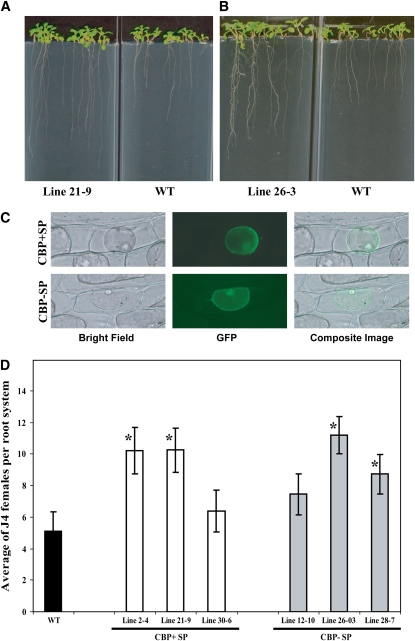Figure 1.
Characterization of Hs CBP.
(A) and (B) Expression of Hs CBP in Arabidopsis increases root length. Homozygous T3 lines expressing either Hs CBP with (A) or without (B) signal peptide exhibited significantly longer root systems ranging from 21.68 mm ± 0.91 mm to 33.09 mm ± 2.03 mm in the transgenic lines expressing CBP with signal peptide and 26.67 mm ± 1.57 mm to 33.88 mm ± 0.82 mm in the transgenic lines expressing CBP without signal peptide compared with wild-type C24 (16.71 mm ± 0.97 mm) at 10 d after planting as determined by unadjusted paired t tests (P < 0.01). This observation was true with all six homozygous T3 lines tested.
(C) Subcellular localization of Hs CBP. Hs CBP cDNA with or without signal peptide-coding sequence was fused to the GFP and GUS reporter genes and expressed in onion epidermal cells. After plasmolysis, GFP fluorescence was retained inside the protoplast in both cases.
(D) Transgenic Arabidopsis plants expressing Hs CBP showed enhanced susceptibility to H. schachti. Homozygous T3 lines expressing either Hs CBP with (lines 2-4, 21-9, and 30-6) or without (lines 12-10, 26-3, and 28-7) the native signal peptide were planted on modified Knop's medium, and 2-week-old seedlings were inoculated with ∼250 surface-sterilized J2 H. schachtii nematodes. Two weeks after inoculation, the number of J4 female nematodes per root system was determined. Data are presented as the mean ± se. Mean values significantly different from the wild type are denoted by an asterisk as determined by unadjusted paired t tests (P < 0.05). Identical results were obtained from at least two independent experiments.

